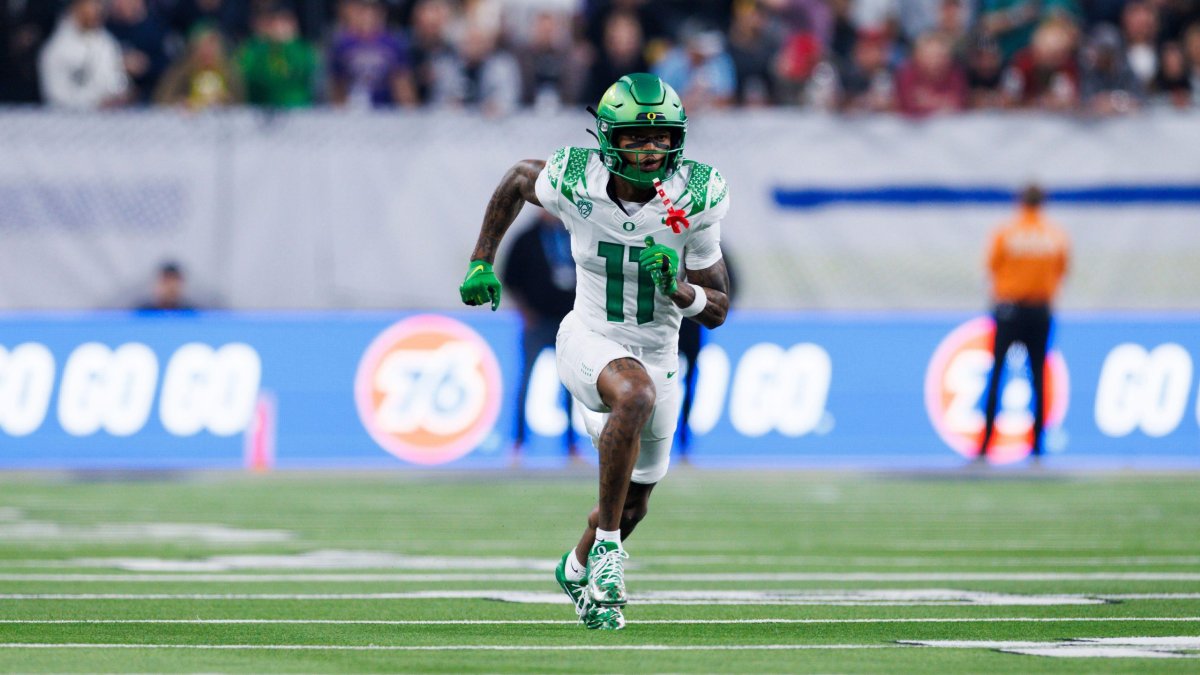• Troy Franklin changed the way Bo Nix attacked the field: Nix had an average depth of target just 6.9 yards downfield last season, but when he targeted Franklin, that number almost doubled to 13.0 yards.
• Not just a lethal deep threat: Franklin‘s ability to run routes, defeat press coverage at the line and run after the catch means there’s a chance he can be a lot more than a deep threat in the NFL.
• Draft and trade for yourself: Try PFF's Mock Draft Simulator — trade picks and players and mock for your favorite NFL team.
Estimated Reading Time: 5 minutes
Click here for more draft tools:
2024 Mock Draft Simulator | 2024 Big Board | 2024 Draft Guide
2024 Player Profiles | 2024 Mock Drafts | NCAA Premium Stats
The 2024 NFL Draft features an absolutely loaded receiver class, and that’s inevitably going to cause some prospects to slip through the cracks, either in terms of notice or during the draft itself.
When it comes to pre-draft hype, the most obvious victim of that is Oregon’s Troy Franklin.
Currently the No. 8 receiver on the consensus big board, Franklin has an elite statistical profile and a very comparable skill set to LSU’s Brian Thomas Jr., the No. 4 receiver on the consensus board.
You can construct a strong case that Franklin belongs in the first round, as high as the fourth receiver off the board.

At 6-foot-2, he has a long and lanky frame that ran a 4.41-second 40-yard dash at the NFL scouting combine with a 39-inch vertical jump and a sub-7-second three-cone.
He averaged 3.32 yards per route run last season, which trailed only Marvin Harrison Jr., and Malik Nabers in this draft. His 36 explosive plays also tied for third in the class, this time behind only Nabers and Rome Odunze. In both instances, the only players with better numbers than Franklin are the consensus “big three” receivers in this draft, each of whom is expected to be selected in the top 10 and would be the draft's top receiver in most years.
Franklin also changed the way his quarterback played the game. Bo Nix had an average depth of target just 6.9 yards downfield last season, but when he targeted Franklin, that number almost doubled to 13.0 yards. The average depth of target was 8.0 yards for all other receivers, and none of the others cleared 10.0. This was not a product of position, but a dynamic specific to Franklin.
He produced a level of aggressiveness and deep passing from Nix that didn’t exist outside of his targets, reminiscent of when Tyreek Hill’s presence in Kansas City suddenly turned the pathologically conservative thrower Alex Smith into a quarterback who led the league in deep passing.
And these weren’t simply empty targets. Passes thrown Franklin’s way last season generated a 150.9 NFL passer rating, and 145.2 for his entire career.
Franklin will get labeled as a one-dimensional deep threat, in part because of those numbers, but there is more route-running nuance to his game than that. He can defeat press coverage easily with a nasty variety of releases off the line despite his size, and where his questionable play strength shows up is deeper down the field on contested targets. Franklin excels at separating and is very good after the catch. Despite a target map that lends itself to deep catches with limited opportunities for yards after the catch, Franklin averaged 6.8 yards after the catch last season and forced 13 missed tackles along the way. He has several long catch-and-run plays on his tape that show an innate ability to catch the ball without losing speed and find daylight to maximize the gain.
Of course, Franklin isn’t a perfect prospect. If he was, we would be talking about him rightfully belonging on the same level as Harrison, Nabers and Odunze. He does have some weaknesses that those players don’t possess, and functional play strength — particularly at the catch point — is the most obvious.
His contested catch rate last season was just 37.5%, bringing him to 41.9% for his career. That’s a notoriously unstable data point — it can fluctuate wildly year to year — but it doesn’t mean there is no signal in the noise. Franklin isn’t great at the catch point, and between those numbers and his career 8.8% drop rate, the data backs up the tape that shows a clear difference between him and the other top receivers when the ball is in the air. This is the main thing that separates him from the big three, but it doesn’t necessarily separate him from Thomas, who has similar deficiencies yet is seen as the next-best receiver by many.
Thomas caught 58.3% of his contested targets last season but recorded just a 51.5% career rate, and his drop rate in college was 10.5%. Both of those data points were much better in 2023, so Thomas comes into the NFL off his best performance in both areas. But as mentioned before, they are extremely unstable data points. Thomas was better than Franklin in both areas in 2023, but they are more closely aligned over their careers.
The bottom line is that Franklin has already demonstrated he can be a lethal deep threat, and that in itself is valuable to a lot of teams, but his ability to run routes, defeat press coverage at the line and run after the catch means there’s a chance he can be a lot more than that in the NFL, just as he was in college. For the teams at the bottom of the first round with receiver needs — including two of the best offenses of recent seasons, Buffalo and Kansas City — Franklin should be a very live option.





 © 2024 PFF - all rights reserved.
© 2024 PFF - all rights reserved.